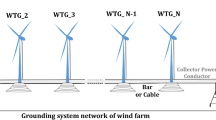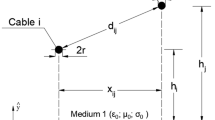Abstract
Propagation of electromagnetic lightning transients modeling in the electrical network is not an easy task because of the large dimensions of its various equipment (length of power lines and ground wires, height of towers…). The full wave numerical methods well known in modeling, generally based on the mesh of the electromagnetic device to construct a system of equations, can prove to be cumbersome or even inapplicable to treat this problem. To study the lightning direct impact on a towers cascade equipped with its lines and earth connections, this article presents a realistic approach based on the transmission line equations. This new modeling, developed directly in the frequency domain, allows taking into account the frequency variations of the ground electrical characteristics in order to analyze properly the grounding systems transient behavior, particularly the Ground Power Rise during a back-flashover.
















Similar content being viewed by others
References
Grcev L (1996) Computer analysis of transient voltages in large grounding systems. IEEE Trans Power Delivery 11(2):815–823. https://doi.org/10.1109/61.489339
Nekhoul B, Labie P, Zgainski FX, Meunier G (1996) Calculating the impedance of a grounding systems. IEEE Trans Magn 32(3):1509–1512
Nekhoul B, Guerin C, Labie P, Meunier G, Feuillet R, Brunotte X (1995) A finite element method for calculating the electromagnetic fields generated by substation grounding systems. IEEE Trans Magn 31(3):2150–2153
Ala G et al (2008) Finite difference time domain simulation of earth electrodes soil ionisation under lightning surge condition. IET Sci Meas Technol 2(3):134–145
Yutthagowith P, Ametani A, Nagaoka N, Baba Y (2011) Application of the partial element equivalent circuit method to analysis of transient potential rises in grounding systems. IEEE Transact Electromag Compct 53(3):726–736. https://doi.org/10.1109/TEMC.2010.2077676
Huangfu Y et al (2015) Modeling and insulation performance analysis of composite transmission line tower under lightning overvoltage. IEEE Trans Magn 51(3):1–4
Yamanaka A et al (2020) Circuit model of vertical double-circuit transmission tower and line for lightning surge analysis considering tem-mode formation. IEEE Trans Power Deliv 35(5):2471–2480
Thang TH, Baba Y, Itamoto N, Rakov VA (2017) FDTD simulation of back-flashover at the transmission-line tower struck by lightning considering ground-wire corona and operating voltages. Electr Power Syst Res 159:17–23. https://doi.org/10.1016/j.epsr.2017.08.021
Sunde ED (1968) Earth Conduction Effects in Transmission Systems. Dover publications, New York
Ametani A (1994) Frequency-dependent impedance of vertical conductors and a multiconductor tower model. IEEE Proceed- Generat Transm Distribut 141(4):339. https://doi.org/10.1049/ip-gtd:19949988
Ametani A, Ishihara A (1994) Investigation of impedance and line parameters of a finite length multiconductor system. Electr Eng Japan 114(4):83–92. https://doi.org/10.1002/eej.4391140408
Wedepohl LM, Wilcox DJ (1973) Transient analysis of underground power-transmission systems: system-model and wave-propagation characteristics. Proc IEEE 120(2):253–260
Kaouche S, Nekhoul B, Kerroum K, El Khamlichi DK, Paladian F (2007) Induced lightning disturbances in a network of aerial shielded cables. Ann Telecommun 62(7–8):894–924
Paul CR (1994) Analysis of Multiconductor Transmission Lines. John Wiley & Sons Inc, New York
Harid N, Griffiths H, Mousa S, Clark D, Robson S, Haddad A (2015) On the Analysis of Impulse Test Results on Grounding Systems. IEEE Trans Ind Appl 51(6):5324–5334. https://doi.org/10.1109/TIA.2015.2442517
IEEE Std 81-1983: IEEE Guide for measuring earth resistivity, ground impedance, and earth surface potentials of a ground system part 1: normal measurements. Power system instrumentation and measurements committee of IEEE power engineering society, 11 March 1983. https://doi.org/10.1109/IEEESTD.1983.82378
Burke G (1992) Numerical electromagnetic code (NEC-4)-method of moment, UCRL-MA-109338. Lawrence Livermore National Laboratory, California
Harrington RF (1968) Field Computation by Moment Method. Macmillan, New York
Grcev L (2009) Modeling of grounding electrodes under lightning currents. IEEE Trans Electromagn Compat 51(3):559–571
Rachidi F et al (2001) Current and electromagnetic field associated with lightning-return strokes to tall towers. IEEE Trans Electromagn Compat 43(3):356–367
Cavka D, Mora N, Rachidi F (2014) A comparison of frequency-dependent soil models: application to the analysis of grounding systems. IEEE Transact Electromagn Compat 56(1):177–187. https://doi.org/10.1109/TEMC.2013.2271913
Visacro S, Alipio R (2012) Frequency dependence of soil parameters: Experimental results, predicting formula and influence on the lightning response of grounding electrodes. IEEE Trans Power Delivery 27(2):927–935. https://doi.org/10.1109/TPWRD.2011.2179070
Longmire CL, Smith KS (1975) A universal impedance for soils. Topical Report for Period, 1 July 1975–30 September 1975. Defense Nuclear Agency, Santa Barbara, CA, USA, Contract No. DNA 001-75-C-0094. https://apps.dtic.mil/sti/citations/ADA025759
Salarieh B (2019) Electromagnetic transient modelling of power transmission line tower and tower-footing grounding system. PhD thesis in science, University of Manitoba, CANADA.
Grcev L (2010) High-frequency grounding. In: Cooray V (ed) Lightning Protection. Institution of Engineering and Technology, pp 503–530. https://doi.org/10.1049/PBPO058E_ch10
Author information
Authors and Affiliations
Corresponding author
Additional information
Publisher's Note
Springer Nature remains neutral with regard to jurisdictional claims in published maps and institutional affiliations.
Appendices
Appendix A: The impedance [Z] and admittance [Y] expressions for grounding conductors, for towers and the ground's impedance expression of an overhead line above a finite conductivity soil
1.1 A.1. Expressions of per-unit length impedance [Z] and admittance [Y] of grounding conductors:
The filiform nature of the conductors constituting the grounding system and the significant spectral content of the fault currents not exceeding 10 MHz, are factors favoring the modeling of a grounding by the transmission lines theory.
The representation of a simple electrode buried horizontally or vertically is introduced for the first time by E. D. Sunde [9]. In his book, E. D. Sunde offers a large work devoted to the calculation of the per-unit length parameters of earth electrodes mainly based on images theory [9]. (Fig. 17).
-
For an electrode buried horizontally [9]: For an electrode of “l” length buried horizontally at a depth h, in a soil of finite conductivity, the per-unit length parameters are as follows:
$$ G = \frac{\pi }{{\rho_{{{\text{sol}}}} .\left[ {ln\left( {\frac{2.l}{{\sqrt {2.h.r} }}} \right) - 1} \right]}} $$(A.1)$$ C = { }\frac{{\pi .\varepsilon_{{{\text{sol}}}} }}{{\left[ {\ln \left( {\frac{2l}{{\sqrt {2.h.r} }}} \right) - 1} \right]}} $$(A.2)$$ L = \frac{\mu }{\pi }.\left[ {\ln \left( {\frac{2.l}{{\sqrt {2.h.r} }}} \right) - 1} \right] $$(A.3)$$ R = \frac{{\rho_{C} }}{S} $$(A.4)\(\rho_{{{\text{soil}}}}\) and \(\varepsilon_{{{\text{soil}}}}\) are the electrical resistivity and permittivity of the soil, \(r\) the radius of the electrode, \(\rho_{C}\) its resistivity and \(S = \pi .r^{2}\) its section.
-
For a vertical rod [9]: By the theory of images, E. D. Sunde subtracts the expressions of the per-unit length parameters of a vertical rod, of “l” length, which are [9]:
$$ G = { }\frac{2\pi }{{\rho_{s} .\left[ {ln \left( {\frac{4.l}{r}} \right) - 1} \right]}} $$(A.5)$$ C = \frac{{2\pi .\varepsilon_{s} }}{{\left[ {\ln \left( {\frac{4.l}{r}} \right) - 1} \right]}} $$(A.6)$$ L = \frac{\mu }{2\pi }\left[ {\ln \left( {\frac{4.l}{r}} \right) - 1} \right] $$(A.7)
The internal per-unit length resistance R keeps the same expression as a horizontal electrode, (the equation (A.4)).
1.2 A.2. Expressions of impedance [Z] and admittance [Y] of towers:
In our study, we opt for the modeling of the "tower – grounding" system by the transmission lines theory, taking a more complete modeling and in order to be as close as possible to reality (study of complex structures) and to have a convenient implementation with a tolerable calculation time.
-
The impedance and admittance of the vertical tower segments: Ametani et al Approach [10]
Consider a multi-conductor system of vertical columns (Fig. 18). For this system A. Ametani et al. [10] expresses the mutual impedance between two cylindrical vertical conductors, as follows:
With:
Whose different geometric dimensions, see (Fig. 18), are calculated as follows:
A. Ametani [10] formulates the following expression for the coefficients \({P}_{ij}\):
In which:
\(h_{1} = h_{n} - h_{S}\),\( h_{2} = h_{m} - h_{S}\),\( h_{3} = h_{n} - h_{r}\),
\(h_{4} = h_{m} - h_{r}\),\( h_{5} = h_{n} + h_{S} + 2h_{e}\),
\(h_{6} = h_{m} + h_{S} + 2h_{e}\),\( h_{7} = h_{n} + h_{r} + 2h_{e}\),
The self-impedance of a conductor i is calculated from the self-coefficients \( P_{ii}\), which are obtained by operating, in the expression of the \( P_{ij}\), the following changes:\( d = r_{i} , h_{S} = h_{n}\) and \( h_{r} = h_{m}\). This gives:
Finally, in order to calculate the self per-unit length capacity, the soil is considered perfectly conductive, by laying the penetration depth \(h_{e} = 0\) in the expression of the coefficients \(P_{ii}\) to have the coefficients \(P_{0ii} \) characterizing a perfect soil [10]. Which gives:
The per-unit length impedance and admittance are \(\underline {Z} = Z_{ii}\) and \(\underline {Y} = j\omega C\).
-
The impedance and admittance of the horizontal arms: Ametani et al Approach [11]
Either a multi-conductor system of finite lengths, whose return is through the ground (Fig. 19).
The self and mutual per-unit length impedances of this system can be determined as follows [11]:
With:
\(M_{d} \): Direct mutual inductance between conductors i and j [11];
\(M_{i} \): The mutual inductance between conductor i and image j' of conductor j relative to the ground plane.
If the terminal of conductor j,\( x_{j1} = 0\), and the terminals \( x_{i} = x_{j2} = l,\) the coefficients \(P_{ij}^{^{\prime}}\) are expressed:
Hence:
In order to have the self per-unit length impedance \( Z_{ii} = j{\upomega }\left( {{\upmu }_{0} /2{\uppi }} \right).P_{ii}^{^{\prime}} /l\), we put \( j = i , d_{ij} = r_{i} , S_{ij} = 2\left( {h_{i} + h_{S} } \right)\).
For a perfectly conductive ground \( \left( {\rho_{soil} = 0} \right)\), skin depth \( h_{s} = 0\), this gives for the coefficients \(P_{ij}^{^{\prime}} \)[11]:
For which:
If we put \( j = i , d_{ij} = r_{i} , D_{ij} = 2h_{i}\), in the expression of \( P_{0ij}^{^{\prime}}\), we come to the self-coefficients \( P_{0ii}^{^{\prime}}\) and we then deduce the self per-unit length capacity of a finite length horizontal conductor:
Idem, the per-unit length impedance and admittance are therefore: \(\underline {Z} = Z_{ii}\) and \(\underline {Y} = j\omega C\).
1.3 A.3. Expression of the ground impedance of an overhead line above a finite conductivity soil:
For a multi-conductor overhead line (Fig. 20)whose return is via the ground, E. D. Sunde [9], in the form of an integral, gives the correction terms (due to the ground’s finite conductivity) of the per-unit length impedance.
On a frequency band of a few MHz, Sunde [9] offers an excellent logarithmic approximation for these self and mutual correction terms, such as:
With:
\(\sigma_{{{\text{soil}}}}\),\( \varepsilon_{{{\text{rsoil}}}}\) respectively, conductivity, relative permittivity of the soil and \(\gamma_{s}\) is the propagation constant in the soil..
Appendix B: The expressions of the soil electrical parameters variation with frequency
The expressions giving the variation of the soil’s conductivity and relative permittivity as a function of the frequency are as follows:
-
For the Visacro and Alipio formulation [22] :
$$ \sigma_{{{\text{soil}}}} \left( f \right) = \sigma_{{\text{soil 100Hz}}} \times \left\{ {1 + \left[ {1.2.10^{ - 6} \left( {\frac{1}{{\sigma_{{\text{soil 100Hz}}} }}} \right)^{0.73} } \right]\left( {f - 100} \right)^{0.65} } \right\} $$(B.1)$$ \varepsilon_{rsoil} \left( f \right) = 7.6.10^{3} .f^{ - 0.4} + 1.3\, for\;f \ge 10 kHz $$(B.2)
where \(\sigma_{soil 100Hz} { }\) is the ground conductivity at low frequencies (\(f\) = 100 Hz).
-
For the Longmire and Smith formulation [23] :
$$ \sigma_{{{\text{soil}}}} \left( f \right) = \sigma_{{\text{soil 0}}} + 2\pi .\varepsilon_{0} \mathop \sum \limits_{n = 1}^{K} \frac{{a_{n} . \left( {\left( \frac{p}{10} \right)^{1.28} . 10^{n - 1} } \right). \left( {\frac{f}{{\left( \frac{p}{10} \right)^{1.28} . 10^{n - 1} }}} \right)^{2} }}{{1 + \left( {\frac{f}{{\left( \frac{p}{10} \right)^{1.28} . 10^{n - 1} }}} \right)^{2} }} $$(B.3)$$ \varepsilon_{{{\text{rsoil}}}} \left( f \right) = \varepsilon_{\infty } + \mathop \sum \limits_{n = 1}^{K} \frac{{a_{n} }}{{1 + \left( {\frac{f}{{\left( \frac{p}{10} \right)^{1.28} . 10^{n - 1} }}} \right)^{2} }} $$(B.4)
With:
\(p\) is the water percentage in the soil, \(a_{n} { }\) are coefficients shown in the reference [23]. According to Longmire and Smith [23], the soil’s conductivity and relative permittivity, at each frequency, are a function of its water content.
Rights and permissions
Springer Nature or its licensor (e.g. a society or other partner) holds exclusive rights to this article under a publishing agreement with the author(s) or other rightsholder(s); author self-archiving of the accepted manuscript version of this article is solely governed by the terms of such publishing agreement and applicable law.
About this article
Cite this article
Kaouche, S., Nekhoul, B. Modeling of lightning surges on a grounding system of a tower cascade. Electr Eng 105, 1125–1139 (2023). https://doi.org/10.1007/s00202-022-01720-3
Received:
Accepted:
Published:
Issue Date:
DOI: https://doi.org/10.1007/s00202-022-01720-3








